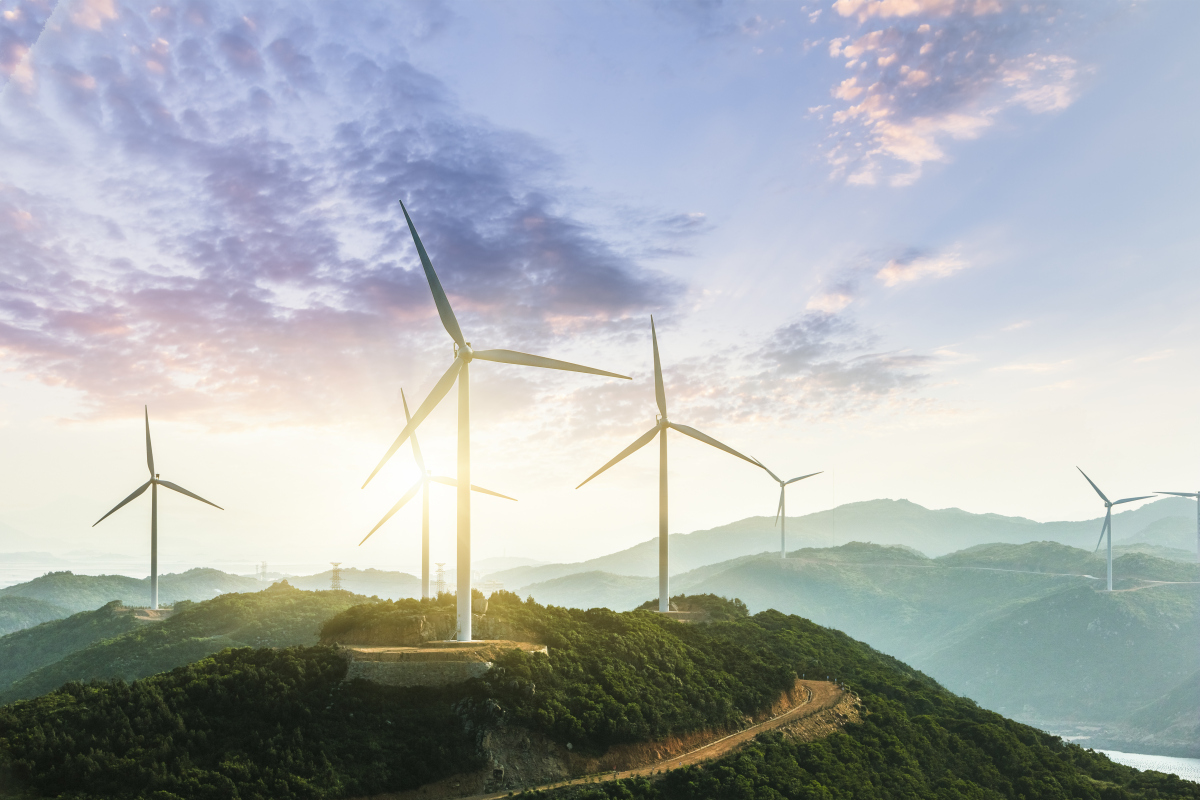
On Tuesday last week during the virtual opening of the UN General Assembly, there came an ambitious announcement by H.E. Xi Jinping President of the People’s Republic of China, related to climate change and global emissions. According to the official translation on the Ministry of Foreign Affairs of the People’s Republic of China, the President said the following within a longer speech;
Third, COVID-19 reminds us that humankind should launch a green revolution and move faster to create a green way of development and life, preserve the environment and make Mother Earth a better place for all. Humankind can no longer afford to ignore the repeated warnings of Nature and go down the beaten path of extracting resources without investing in conservation, pursuing development at the expense of protection, and exploiting resources without restoration. The Paris Agreement on climate change charts the course for the world to transition to green and low-carbon development. It outlines the minimum steps to be taken to protect the Earth, our shared homeland, and all countries must take decisive steps to honour this Agreement. China will scale up its Intended Nationally Determined Contributions by adopting more vigorous policies and measures. We aim to have CO2 emissions peak before 2030 and achieve carbon neutrality before 2060. We call on all countries to pursue innovative, coordinated, green and open development for all, seize the historic opportunities presented by the new round of scientific and technological revolution and industrial transformation, achieve a green recovery of the world economy in the post-COVID era and thus create a powerful force driving sustainable development.
Source: Ministry of Foreign Affairs of the People’s Republic of China
The announcement is very good news and may give additional impetus to the Paris Agreement, but what might this look like in practice? The pathway that President Xi outlined is similar to that found in the Shell Sky Scenario, so a look at the numbers within that scenario might give some insight as to what is in store for a China energy transition. Sky is a scenario that illustrates a technically possible, but challenging pathway for society to achieve the goals of the Paris Agreement.
Sky is an energy system only scenario, whereas carbon neutrality in an economy extends more broadly and includes industrial carbon dioxide (e.g. from calcining of limestone to make cement), land use change and may also include agriculture and fugitive emissions of methane and other greenhouse gases from various sources. The statement by President Xi points to this being about carbon dioxide, rather than all greenhouse gases, but that may not be the case and there will doubtless be more detail to follow. The Sky emissions profile is below, with energy system emissions peaking prior to 2030 and net-zero emissions in the energy system in 2080, although emissions are more than 80% reduced and still falling in 2060. It may be the case that this qualifies as ‘carbon neutral’ in 2060 should it be coupled with widespread reforestation in China and the purchase of removal units via reforestation projects in other parts of the world. China appears to have the potential to deliver more than 1 Gt of removals through reforestation by the 2060s.
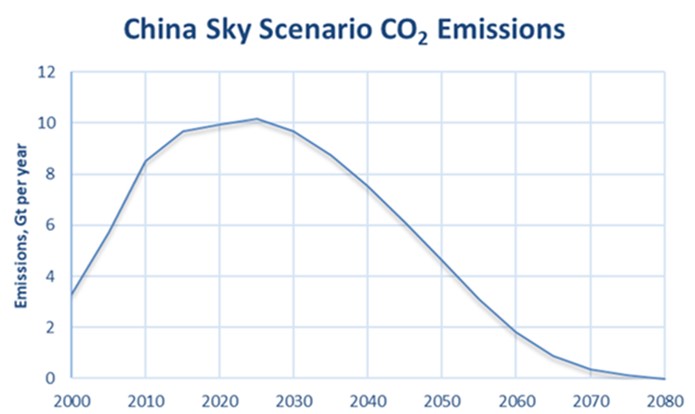
In Sky, the transition is rapid and immediate which it has to be to see emissions peak before 2030. Although COVID-19 also resulted in widespread lockdowns in China, they have seemingly supressed the virus and are in a V-shaped recovery, so the pre-COVID Sky data is still very relevant, even for the 2020s.
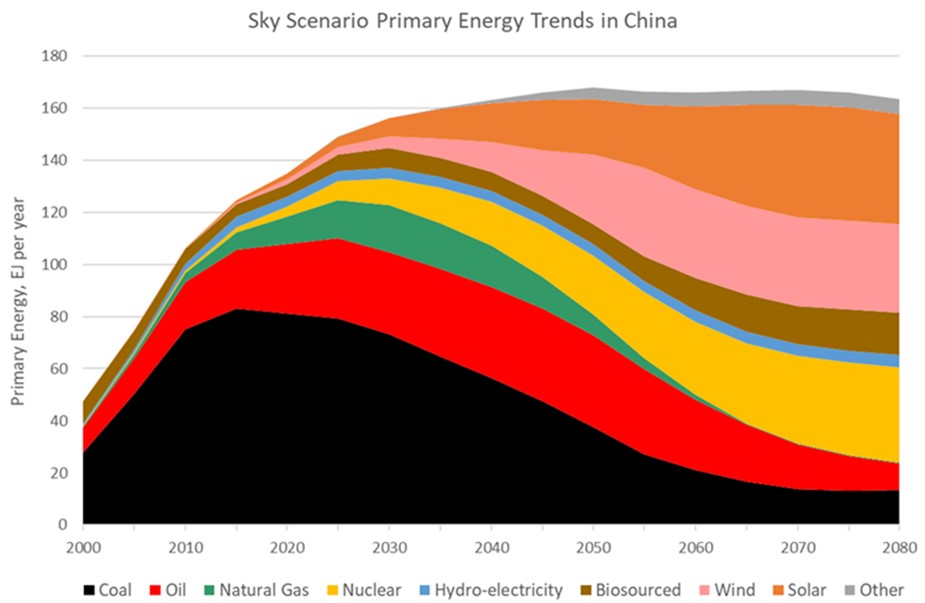
For the scale of transition that China has outlined, peak coal should be in the rear-vision mirror, although the rate of decline in the 2020s is modest. Importantly, the build out rate of nuclear, wind and solar needs to start accelerating in the 2020s, although there is evidence that this is happening. In China, nuclear generation in 2010 was 75 TWh rising to 400 TWh in 2020. In Sky, this rises to around 1000 TWh by 2030. That means China started up some 35 reactors in the 2010s, but needs to start about 80 in the 2020s.
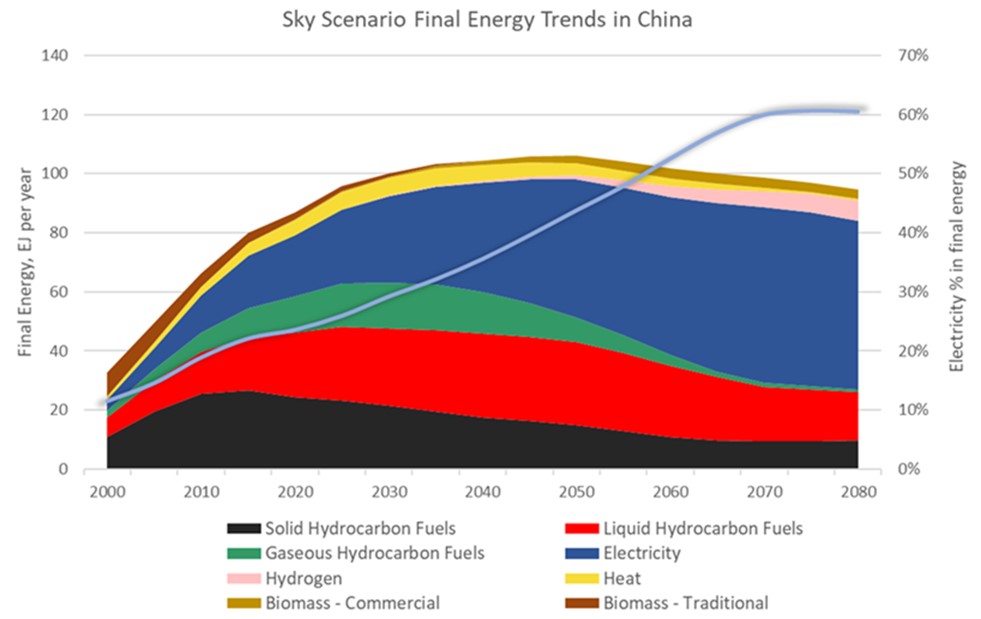
The transition doesn’t stop with the primary energy mix; with so much solar, wind and nuclear in that mix the final energy system trends towards a predominance of electricity. Like most of the world, final energy today in China is just over 20% electricity, but rises to 60% as the economy heads towards net-zero emissions. Today in China, most of the energy used to deliver services is hydrocarbon based; gasoline in cars, Jet-A1 in planes, natural gas in homes and industry, coal in industry and still in many homes. Most of this has to change to reach a net-zero emissions society.
- China is changing rapidly and its capacity to implement change is a constant source of surprise. For example, in the Sky Scenario we originally imagined a longer period of transition to electric vehicles (EV) than, say, the United States. The US story is one in which internal combustion engine (ICE) passenger vehicle sales largely end in the 2030s, but in China they continue for another 10-15 years after that. But today with battery and EV manufacturing increasing rapidly in China, a much faster transition could be envisaged.
- The residential sector is currently heavily dependent on hydrocarbon based fuels for cooking and heating, so this must undergo a very rapid shift to electricity, starting now. This won’t be a simple transition as China is currently increasing natural gas supply to homes as a means of displacing coal. In late 2018, Reuters reported on this as follows;
China has switched another 3.29 million households to gas heating this winter, Reuters calculations show, more than it added last year, as Beijing continues to push the use of cleaner fuels to curb pollution. Gas heating has been installed in recent months across a new swathe of northern China – known for its heavy smog – underlining the government’s commitment to reduce pollution even after last year’s efforts triggered a fuel shortage that left people freezing in their homes.
Source: Reuters
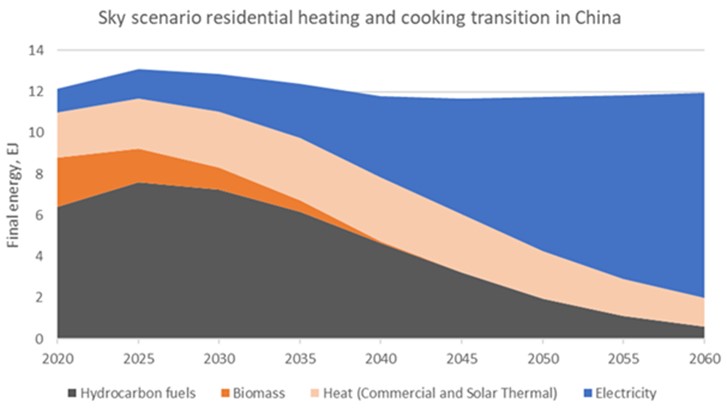
While 3 million homes isn’t large in the Chinese context, infrastructure of this nature is there for the long term, which becomes an obstacle to displacement. In Sky, it takes the full forty years that China has given itself to reach net-zero emissions for hydrocarbon fuels to depart the residential sector.
- China has a very large industrial system and to some extent has become the manufacturer to the world. While much of the high technology industrial manufacturing sector runs on electricity, there is a major dependency throughout the system on metallurgical and petrochemical industries which largely use coal, but also natural gas. There are two routes for electrification of this heavy industry, but neither are simple. One is the direct use of electricity, but not all processes can use electricity (with current cost effective technology) because of the heat intensity required or the role of carbon in the process itself (i.e. iron ore smelting and aluminium electrolysis). The second route is to use renewable electricity to make hydrogen via electrolysis, then use hydrogen in furnaces and for direct reduction. This is also an emerging set of technologies which are far from mature, so it will take many years for these to bed in. Efficiency also plays a major role in reshaping the industrial sector, in part through electrification but also through improved process technology.

Even with electrification being the dominant lever for change in combination with decarbonisation of the power sector, there will still be remaining emissions. Not all industrial processes are suited to electrification and hydrogen will take some time to scale or may not be suitable in particular applications. Fossil fuels may well continue in certain instances as the most effective way of delivering energy services, at least for this century. That then requires direct or indirect management of carbon dioxide with capture and geological storage (CCS).
In Sky, CCS emerges in two ways. One is the direct application on an industrial facility such as a cement plant and the other is the indirect application through BECCS or DACCS to deliver negative emissions. BECCS is the combustion of bioenergy in combination with direct CCS and DACCS is the removal of carbon dioxide from the air with geological storage. The negative emissions that these processes generate can be paired with emissions from a sector such as aviation, which through to 2060 is still likely to be using some fossil fuels (Jet-A1).
The Sky scenario shows a total geological storage requirement in 2060 of just over one billion tonnes of carbon dioxide per year. Not much more than this is ever needed and by the end of the century CCS requirements in China are well in decline as other technologies replace fossil fuels. Nevertheless, this is still 500-1000 big CCS facilities being built over the next 40 years. Importantly, the initial scaling of CCS in China needs to start during the 2020s, so that should be one of the first new initiatives to be visible following Xi’s announcement.
The transition described above will also require significant policy intervention, which in China may come in the form of mandates and standards. However, the government has already embraced carbon pricing with its trial systems running in various provinces over the last few years and the current plan to get a nationwide system up and running. This nationwide system has been somewhat delayed, but is slated to start up in the coming months.
The announcement by President Xi Jinping is very welcome but also very ambitious. However, China has demonstrated time and again over the last twenty years that it can muster enormous capacity for change and implement big infrastructure projects. This transition may be the biggest so far.
To see the Sky Scenario data-set for China, click here.

Average Rating